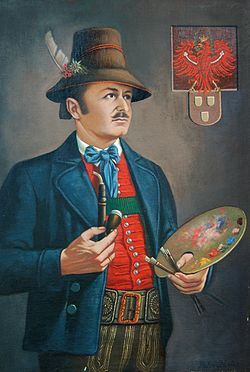
Selbstportrait des Malers Peter Thaler (1891 – 1978) aus St. Johann in Tirol
Self-portraits direct an artist’s gaze inward. Robert Mapplethorpe’s photographs from the 1970s and 1980s include fashion, portraiture, floral arrangements and documentary subject matter. His self-portraits combine elegance in form with an autobiographical journey in content as he travels as a young gifted artist through the darker side of the New York gay S and M scene and ultimately to his death from AIDS at age thirty three.
In contrast to Mapplethorpe’s photos, Chuck Close has been producing portraits of family, friends and himself exclusively since the 1960s. His unconventional style has changed little over the years. Starting from a photograph, he painstakingly translates the image into paintings, prints and drawings using a grid to isolate very small areas of a surface at a time. This slow buildup of form is both mechanical and magical. The resulting portraits stun with their visual presence – the paintings are often eight feet high – and incessant in their flatness to the picture plane. After suffering a spinal chord injury in 1988 that left him severely paralyzed, Close’s signature super-realism has evolved into mosaic-like images that seem at once both realistic and abstract.
Robert Arneson’s ceramic self-portrait California Artist (1982) is satirical in nature. He pokes fun at the classical ideal of sculpture grounded in the Greek and Roman traditions. Instead of appearing as an idealized, mythic god, Arneson presents himself as a balding, middle-aged hippie, set on a chipped pedestal that includes a marijuana plant growing up the front and empty beer bottles and cigarette butts crushed out on its base.
Introduction to Self Portraits
Self-portraits direct an artist’s gaze inward. Robert Mapplethorpe’s photographs from the 1970s and 1980s include fashion, portraiture, floral arrangements and documentary subject matter. His self-portraits combine elegance in form with an autobiographical journey in content as he travels as a young gifted artist through the darker side of the New York gay S and M scene and ultimately to his death from AIDS at age thirty three.
In contrast to Mapplethorpe’s photos, Chuck Close has been producing portraits of family, friends and himself exclusively since the 1960s. His unconventional style has changed little over the years. Starting from a photograph, he painstakingly translates the image into paintings, prints and drawings using a grid to isolate very small areas of a surface at a time. This slow buildup of form is both mechanical and magical. The resulting portraits stun with their visual presence – the paintings are often eight feet high – and incessant in their flatness to the picture plane. After suffering a spinal chord injury in 1988 that left him severely paralyzed, Close’s signature super-realism has evolved into mosaic-like images that seem at once both realistic and abstract.
Robert Arneson’s ceramic self-portrait California Artist (1982) is satirical in nature. He pokes fun at the classical ideal of sculpture grounded in the Greek and Roman traditions. Instead of appearing as an idealized, mythic god, Arneson presents himself as a balding, middle-aged hippie, set on a chipped pedestal that includes a marijuana plant growing up the front and empty beer bottles and cigarette butts crushed out on its base.
Content is available under the
Creative Commons Attribution Share Alike License.
Privacy Policy | Authors